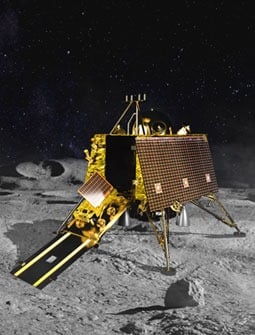After countless delays, India will try to safely land the lander near the South Pole tonight (September 6, 23:30 p.m. Israel time) and remove an all-terrain vehicle from it. After the failed landing of the Israeli spacecraft Genesis 2, India will be the fourth country to land on the moon.
23:30 Contact with the spacecraft is lost. The telemetry stopped, the spaceship seems to have crashed.
https://www.youtube.com/watch?v=CcJwjuo8pBo&feature=youtu.be

Tonight: the landing of the Indian spacecraft Chandrayaan 2 and a space vehicle that will leave it
Update: 23:10 The spacecraft's engines were successfully activated to slow down its speed
After countless delays, India will try to safely land the Chandrayaan-6 lander tonight (between September 7 and 2). After the failed landing of the Israeli spacecraft Genesis 2, India will be the fourth country to land on the moon.
Chandrayaan-2 was launched six weeks ago - more than a year behind the original schedule and includes a spacecraft that will attack the moon and a lander, Vikram, inside which is a six-wheeled vehicle. The mission's main goals are to explore the hitherto unexplored region of the South Pole, and to locate water on the moon.
The landing is expected to be carried out completely autonomously. In 2008, the Chandrayaan 1 orbiter was scrapped on the moon after its mission ended, but this time it was intended to make a soft landing.
When Vikram is at an altitude of 35 km above the surface of the moon, its engines will be activated to slow down the speed of the spacecraft's descent from 6 km per second to almost zero. The Indian space agency ISRO hopes that the lander will not encounter small rocks that will interfere with the landing. The landing area is at least clear of large rocks.
The head of the Indian space agency, Kailaswadivo Sivan, said at a press conference last month that the automatic landing would be the "scariest moments" for the organization.
If the landing is successful, the Vikram lander will be the first spacecraft to land near the south pole of the Moon. A few hours later, it is expected to release the Pragyan SUV, which will be able to travel up to a distance of 500 meters from the lander.
The most important reason for choosing the site is the high probability of finding water there, says Milaswami Annadurai, former director of the ISRO Satellite Center (now the UR Rao Satellite Center) in Bangalore, who led the Chandrayaan-2 project until he retired. In July 2018.
Ever since Chandrayaan-1 discovered signatures of frozen water on the moon, scientists have been trying to identify more ice deposits and calculate how much water is there. Since then, water has been discovered by additional spacecraft, and now a lander and rover are arriving to examine the situation on the ground.

One response
Ding dega dong diggy ding gang gong ding gang ding gang ding gang gong ahhhhhhhhhhhh! Ichikadana in Ichikadana Dana and Bardana Ichikadana…
where is sasson
He's in the baggage!
what are you stupid Get him out of there he will choke!